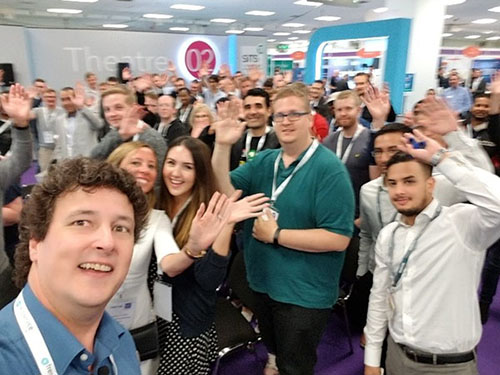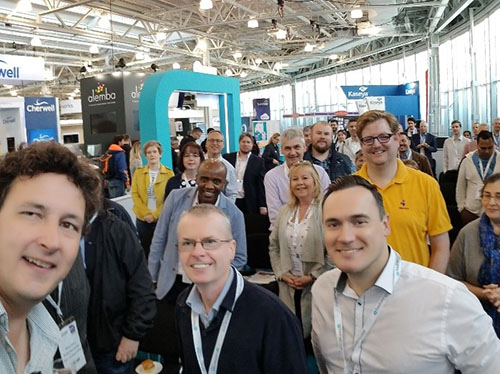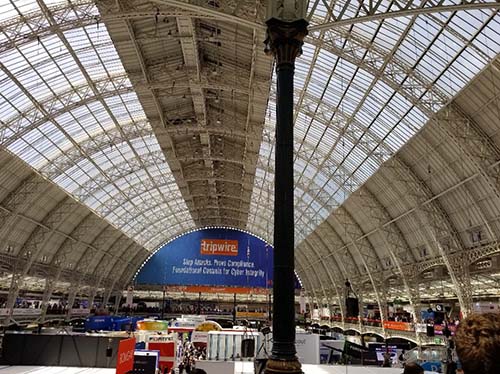For the third year in a row, I was asked to give a couple of talks at Service Desk Show, commonly called SITS, which is co-located with the InfoSec show. While there, I presented on the state of the help desk in 2018, as well as about threat hunting. I was also able to glean quite a few insights – as well as a selfie or two – as I talked with IT pros at the sessions I led.

Figure 1: Help desk folks at the security threat hunting session

Figure 2: Help desk folks at the future of the help desk session
The SITS show was held at a venue called Olympia London, which is in a section of London called Hammersmith. For anyone who knows classic rock and roll concerts well, you’ve likely heard of the Hammersmith Odeon.

Figure 3: Olympia, London
It’s where a lot of classic concerts were held and is even referenced in the Motorhead album, No Sleep ‘til Hammersmith. That album is where the Beastie Boys got the idea for their later No Sleep ‘til Brooklyn album. I was lucky enough to stop there and take a picture of my own little UK tour of the Odeon (now re-named the Apollo) to present at SITS.

Figure 4: No sleep ‘til the Service Desk Show!
In between my presentations (and after), I was able to attend quite a few learning sessions on topics like the following:
- Working with security teams
- The importance of implementing backup
- More efficient use of help desk tickets and troubleshooting data
- New skills, including scripting and automation, as well as remote access techniques
Let me expand on each of these a bit.
Working with Security Teams
One of the big topics was that the help desk should work with security professionals more closely. That’s why I was asked to present about threat hunting and how to work with pen testers, security analysts, and security operations center (SOC) employees. In fact, several help desk managers approached me afterward with stories about how their workers are increasingly being asked to support security workers.
Zeshan Zattar, who works in CompTIA’s UK office, told me even more about how many of today’s help desk pros are now working side by side with SOC workers. That’s right – help desk folks and SOC monitors are starting to pretty much work from the same desk.
On the one hand, I like the idea of security workers rubbing elbows with help desk folks. After all, it’s well-known that hackers primarily use social engineering to gain access to systems. Therefore, it’s natural for SOC employees to work closely with help desk folks. But, this should only happen if the help desk folks report to the chief information officer and the SOC employees report through the chief information security officer or another reporting pathway. Segregation of duties is essential.
The Help Desk and Backup Services
Increasingly, the help desk is expected to help with traditional enterprise as well as cloud-based backup and recovery. With all of this talk about security and backup, it’s interesting to see how the help desk role is continuing to morph.
How?
I’m seeing how the help desk is doing more than troubleshoot network and endpoint device connectivity issues. They’re now getting involved in business continuity. This makes sense to me – the help desk is a vital contributor to making sure that a company can respond positively to various technical shocks to its system and keep running.
More Efficient Use of Help Desk “Artefacts”
I was struck by the number of discussions on the importance of writing quality documentation to capture what I have called “artefacts” left behind by help desk professionals as they support end users. I presented about the importance of learning how to categorize and write up detailed tickets, as did many others.
This is because organizations increasingly want to mine the wisdom of help desk professionals. They want to do big data reviews of tickets. Hiring managers want to do more than just achieve faster response times and solutions times. Far from replacing help desk folks, they simply want to leverage the information help desk pros generate as they support end users.
For example, I spoke in my own session about how one organization was able to read help desk tickets about malfunctioning printers to more easily discover botnet and/or ransomware attacks. Other presenters went into detail about how it’s important for help desk folks to learn how to write and record better to improve help desk knowledge bases. As organizations can better sift through these artefacts, they’ll be able to make their organizations far more efficient.
New Skills at the Help Desk
The sessions I attended talked about the importance of using scripts to automate tasks, as well as engage in tasks such as the following:
- Operating system hardening
- Creating backups
- Using alternatives to remote desktop protocol (RDP), including the use of secure shell (SSH) tunneling and OpenVNC, and, of course, LogMeIn
- Deploying cloud services
Finally, I saw that the help desk needs to support new types of networking. It was too early to talk about 5G networking. But, there was plenty of discussion about how to support low-power, mesh networks, such as Z-Wave and Zigbee.
I was almost able to start a knife fight – I mean, debate – between a few folks arguing about which was better. But instead, I stepped in and stated that each has its own uses. Z-Wave works best in busy environments (where lots of other devices are working), because it avoids the 2 GHZ band. Zigbee uses the busy 2-GHZ band but supports more devices and uses lower power, which means that it might be cheaper to implement at times. That seemed to calm things down a bit.
Conclusion
It was fun soaking up all of this information, both at the sessions and also at our CompTIA booth.

Figure 5: Some of the CompTIA team at the SITS booth
While in the United Kingdom, I climbed a mountain called Helvellyn and visited the launch site of the SS Great Eastern. One of the great industrial wonders of the world, she helped lay down the very first transatlantic cable, another great technological wonder.

Figure 6: My view of Striding Edge, Helvellyn

Figure 7: The launch site of the SS Great Eastern
I also visited the area of Royal Observatory at Greenwich, the land where time began. It was really cool to see how the United Kingdom has led the world in technology for centuries, and continues to do so, with other countries such as Sweden, Japan and Singapore.

Figure 8: Visiting Greenwich, where modern time began
I’m looking forward to the next show. Next time, I think I may visit the Battersea Power Station, which is on the cover of Animals, probably my favorite Pink Floyd album. More to the point, I’m looking forward to talking about how the help desk continues to morph. If this third time presenting at SITS was the charm, then I’m thinking the fourth time will deliver even more insights about tech trends in the help desk workplace.
Launch your service desk career with CompTIA A+.
